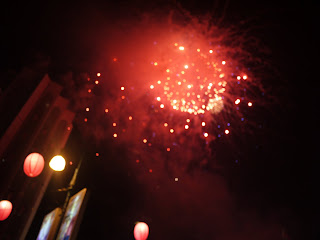Another Day….Another Festival/Holiday
Last Saturday (September 10) we went to a celebration of the
Mid-Autumn festival with a lantern parade. The celebration we went to was sponsored by the Ministry of Tourism
and was held outside of
Pasar Seni (the old central market in Chinatown). We knew the festival was close at hand when every marketplace (Starbucks included) was selling
Moon Cakes. A Chinese baked good traditionally filled with lotus bean paste and single or double salted egg yokes (don’t try to bring the versions containing the eggs back to the US/Australia as they will be confiscated at the border). They taste good and disappear immediately following the festival. (Aside, what is great is they are made with no preservatives.)
Hundreds of chairs were set out with gift bags for the invited guests.
Guest included the Minister of Tourism and the Prime Minister and his wife. Entertainment was provided to warm up the audience. It included a Michael Jacksonesque singer (who would not make the cut for a lounge act in Las Vegas).
In the parking lot were carnival booths.
They were aimed at small children with parents attempting to retrieve stuffed dolls, ducks, tigers, etc. No money was exchanged as newspaper coupons were used. The line got long as the night wore on. In another section of the parking lot trucks were disgorging 8 Chinese lions for the lion dancers who led the parade later in the evening. Large drums were unloaded and people began to practice their drumming rhythms.
Since the start of the event was several hours away, we decided to do some shopping as the Pasar Seni was close at hand. I purchased two shirts (light weight cotton material). Around 7 PM eating became imperative. We went to the Hong Key claypot street restaurant off Jalan Petaling.
We were relatively early and were placed near a fan. We ordered our meal, claypot chicken rice, eggplant, limau eis, and a beer. Meanwhile we began to talk to two people at an adjacent table. They were both originally from Penang. Our food arrived, and then to our surprise the woman at the adjacent table gave us a small portion of their fish dish (Portugese style sting ray) and it was both spicy and delicious. The claypot chicken arrived in hot claypots. We needed to constantly stir the contents to keep it from scorching on the bottom. Because this version had plenty of Chinese pork sausage, it was wonderful. The spicing came from the sausage. Total cost was less than RM 40 including beverages.


It was dark (here in Kuala Lumpur the balance between daylight and night time is relatively equal year round). Back at the Pasar Seni parking lot, dignitaries were arriving. The Tourism Minister spoke briefly, and the Prime Minister came up to the stage, but gave no speech. The group of dignitaries gathered on the stage and sang the 1Malaysia theme song. 1Malaysia is a government initiative focused on “racial harmony” and a united Malaysia. Arial fireworks went off, with the LRT trains passing by in the background.
The
Lion Dancers began their performance. They are truly amazing. Two people manage to make the costumes come alive. Each animal has a personality.
With 8 of them it was a great sight. Meanwhile people went through the crowd distributing gift bags containing paper lanterns, candles, matches, snacks, water, electric lighter wand, and a Malaysian Flag. (A trivia question: what two flags contain 13 red and white stripes.) We lit our lanterns and walked over to an area where children were lighting candles on the ground.
The parade was led by the Lion Dancers, the drummers, and a troupe of people following with their lanterns.
At this point we departed.
Next holiday: Malaysia Day.










